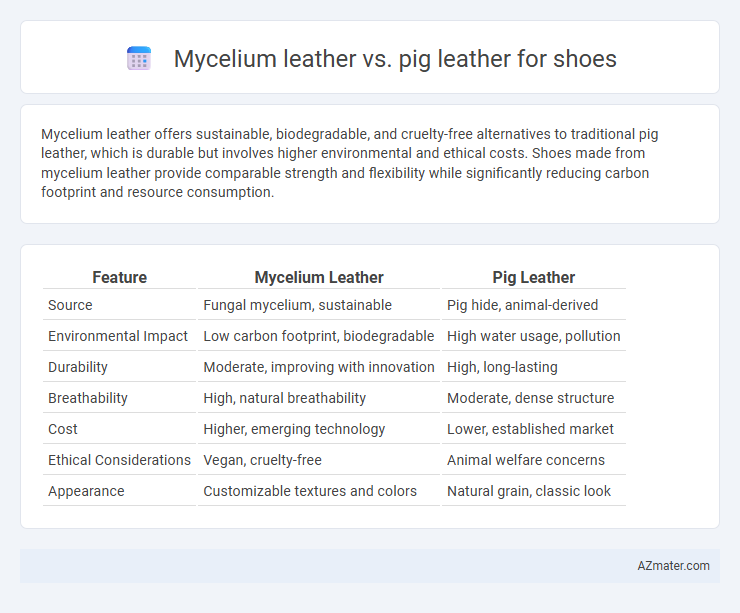Mycelium leather offers sustainable, biodegradable, and cruelty-free alternatives to traditional pig leather, which is durable but involves higher environmental and ethical costs. Shoes made from mycelium leather provide comparable strength and flexibility while significantly reducing carbon footprint and resource consumption.
Table of Comparison
| Feature | Mycelium Leather | Pig Leather |
|---|---|---|
| Source | Fungal mycelium, sustainable | Pig hide, animal-derived |
| Environmental Impact | Low carbon footprint, biodegradable | High water usage, pollution |
| Durability | Moderate, improving with innovation | High, long-lasting |
| Breathability | High, natural breathability | Moderate, dense structure |
| Cost | Higher, emerging technology | Lower, established market |
| Ethical Considerations | Vegan, cruelty-free | Animal welfare concerns |
| Appearance | Customizable textures and colors | Natural grain, classic look |
Introduction to Mycelium Leather and Pig Leather
Mycelium leather, derived from the root structure of fungi, offers a sustainable and eco-friendly alternative to traditional pig leather, which is harvested from pighide through chemical-intensive tanning processes. Unlike pig leather, known for its durability and natural grain patterns utilized in shoe manufacturing, mycelium leather provides a biodegradable material with customizable texture and reduced environmental impact. Both materials serve the shoe industry, but mycelium leather represents innovation in sustainable fashion, while pig leather remains a conventional choice valued for its strength and aesthetic appeal.
Production Processes: Mycelium vs Pig Leather
Mycelium leather production involves cultivating fungal mycelium on organic substrates, utilizing a sustainable, low-water, and low-energy process that minimizes environmental impact and avoids animal farming. Pig leather production requires raising and slaughtering pigs, followed by tanning processes that often use toxic chemicals such as chromium, generating significant waste and pollution. The scalable and biodegradable nature of mycelium leather contrasts with the resource-intensive, pollutive, and ethically challenging aspects of pig leather manufacturing.
Sustainability and Environmental Impact
Mycelium leather, derived from fungal mycelium, offers a sustainable alternative to pig leather by significantly reducing environmental impact through lower water usage, minimal chemical processing, and faster biodegradability. Pig leather production contributes to deforestation, high greenhouse gas emissions, and extensive water contamination from tanning processes. Choosing mycelium leather over pig leather supports carbon footprint reduction and promotes eco-friendly footwear manufacturing.
Durability and Longevity Comparison
Mycelium leather offers superior durability with its natural fiber structure resisting wear and tear better than traditional pig leather, which tends to crack and degrade over time. Mycelium leather's resistance to moisture and UV damage significantly extends the shoe's lifespan compared to pig leather, which is prone to drying out and fading. This makes mycelium leather a sustainable and longer-lasting alternative for high-performance footwear.
Comfort and Breathability
Mycelium leather offers superior breathability compared to pig leather due to its natural, porous structure that facilitates better air circulation and moisture absorption, enhancing overall foot comfort. Pig leather, while durable, tends to be less breathable, which can lead to increased foot sweating and discomfort during extended wear. The lightweight and flexible nature of mycelium leather also contributes to improved comfort by allowing the shoe to adapt more easily to foot movements.
Aesthetic Qualities and Customization
Mycelium leather offers a unique, natural grain and texture that can be easily customized through dyeing and embossing, providing a modern and eco-friendly aesthetic ideal for innovative shoe designs. Pig leather, known for its porous texture and durability, presents a classic and traditional look favored in high-quality footwear, with limited customization options primarily focused on finishing and color. Both materials allow for distinct visual appeal, but mycelium leather excels in versatility and sustainable customization while pig leather maintains a timeless, rugged charm.
Cost and Market Availability
Mycelium leather is typically more expensive than pig leather due to its innovative production process and limited large-scale manufacturing, but it offers a sustainable alternative that is gaining market interest. Pig leather remains widely available and cost-effective, benefiting from established supply chains and mass production capabilities. Despite higher initial costs, mycelium leather's eco-friendly properties drive growing demand in niche markets focused on sustainability and innovation.
Ethical Considerations
Mycelium leather offers a sustainable and cruelty-free alternative to traditional pig leather, significantly reducing animal harm and environmental impact associated with livestock farming. This biofabricated material requires less water, land, and emits fewer greenhouse gases compared to pig leather production, aligning with ethical consumer values. Choosing mycelium leather for shoes supports animal welfare and promotes eco-friendly practices in the fashion industry.
Maintenance and Care Requirements
Mycelium leather for shoes offers superior ease of maintenance due to its natural resistance to water and stains, requiring only occasional light cleaning with a damp cloth. Pig leather demands more frequent conditioning and protection from moisture to prevent cracking and preserve its durability. Choosing mycelium leather reduces long-term care efforts while maintaining aesthetic appeal and structural integrity in footwear.
Future Trends in Footwear Materials
Mycelium leather is emerging as a sustainable alternative to pig leather in the footwear industry, offering biodegradability and lower environmental impact. Innovations in mycelium processing enhance durability and texture, making it increasingly viable for high-quality shoe production. Market trends indicate growing consumer demand for eco-friendly materials, driving investment in mycelium leather technology to replace traditional animal-based leathers in future footwear designs.

Infographic: Mycelium leather vs Pig leather for Shoe
 azmater.com
azmater.com